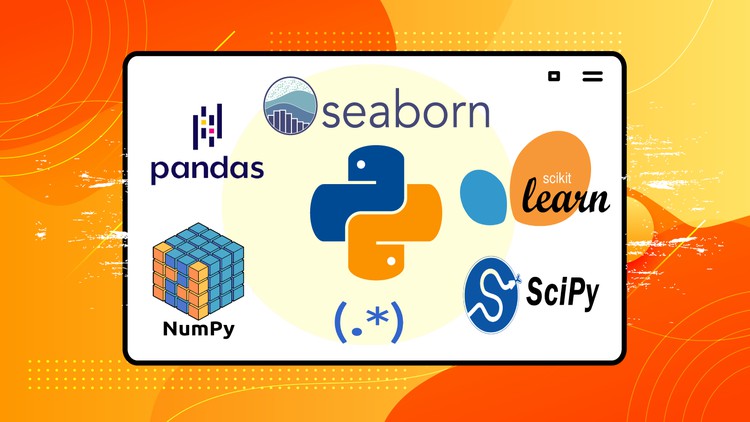
What you will learn
Python – Bootcamp
SciPy – Scientific Python Software Stack
NumPy – Numerical Array Processing
Matplotlib – 2D Plotting and Visualization
Pandas – Data Frames & CSV Files
Scikit Learn – Python Machine Learning
Seaborn – Statistical Plotting
REGEX – Python RE (Regula Expressions)
PyTorch – Python Tensor Flow
Python – Data Mining Pipeline
Description
18 HRS OF AWESOME FIVE STARS ⭐⭐⭐⭐⭐ VIDEOS!
This is the Best and Most Complete Scientific Python Course on the Udemy platform that will walk you through the required skills for Data Sciences and useful Machine Learning (ML) libraries such as NumPy, Pandas, Scikit-Learn, Seaborn, Python RE (REGEX), PyTorch and Matplotlib. Furthermore, you learn how to work with different real datasets and use them for developing your models. All the Python code templates that we write during the course together are available, and you can download them with the resource button of each section.
WHAT YOU WILL GET & LEARN?
In this awesome 18 hours long course we will cover:
-
SciPy is a free and open-source Python library used for scientific computing and technical computing. It contains modules for optimization, linear algebra, integration, interpolation, special functions, FFT, signal and image processing, ODE solvers and other tasks common in science and engineering. The SciPy library is currently distributed under the BSD license, and its development is sponsored and supported by an open community of developers.
-
NumPy is a library for the Python programming language, adding support for large, multi-dimensional arrays and matrices, along with a large collection of high-level mathematical functions to operate on these arrays.
-
Matplotlib is a comprehensive library for creating static, animated, and interactive visualizations in Python. Most of the Matplotlib utilities lies under the pyplot submodule, and are usually imported under the plt alias.
-
Pandas is a software library written for the Python programming language for data manipulation and analysis. In particular, it offers data structures and operations for manipulating numerical tables and time series. It is free software released under the three-clause BSD license.
-
Scikit-learn: Simple and efficient tools for predictive data analysis · Accessible to everybody, and reusable in various contexts · Built on NumPy, SciPy, and matplotlib.
-
Seaborn: Seaborn is a Python data visualization library based on matplotlib. It provides a high-level interface for drawing attractive and informative statistical graphics.
-
Python REGEX Regular expressions (called REs, or regexes, or regex patterns) are essentially a tiny, highly specialized programming language embedded inside Python and made available through the re module.
-
All data sets included!
Python is a great tool for the development of programs which perform data analysis and prediction. It has tons of classes and features which perform the complex mathematical analysis and give solutions in simple one or two lines of code so that we don’t have to be a statistic genius or mathematical Nerd to learn data science and machine learning. Python really makes things easy.
Students purchasing this course will receive free access to the interactive version (with Scientific code playgrounds) of this course from the Scientific Programming School (SCIENTIFIC PROGRAMMING IO). Based on your earlier feedback, we are introducing a Zoom live class lecture series on this course through which we will explain different aspects of Linux command line Python for Data analytics. Live classes will be delivered through the Scientific Programming School, which is an interactive and advanced e-learning platform for learning scientific coding.
MONEY BACK GUARANTEE IF NOT 100% SATISFIED!
When you enroll you will get lifetime access to all of the course contents and any updates and when you complete the course 100% you will also get a Certificate of completion that you can add to your resumé/CV to show off to the world your new-found Python & Scientific Computing Mastery! Don’t forget to join our Q&A live community where you can get free help anytime from other students and the instructor. This awesome course is a component of the Learn Scientific Computing master course.
So What are you Waiting For? Click that shiny enroll button and we’ll See you inside 😉
Content